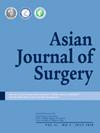The application of hepatopancreatoduodenectomy in advanced gallbladder carcinoma: Patient selection, surgical outcomes and influence on survival compared to radical cholecystectomy
IF 3.5
3区 医学
Q1 SURGERY
引用次数: 0
Abstract
Aim
to investigate hepatopancreatoduodenectomy (HPD) application in gallbladder carcinoma (GBC) and compare it to radical cholecystectomy (RC) regarding patients’ characteristics, surgical outcome and survival.
Methods
Patients treated in our center were included. Three groups (HPD, RC, no-surgery) were compared. Comparisons included basic characteristics, liver function, tumor biomarkers, surgical complications, outcome, and survival. Differences in severity, surgical risks and survival were investigated.
Results
In total, 19 patients in HPD, 89 in RC and 20 in no-surgery groups were included. Median follow-up was 42.0 months. Compared to RC, HPD group revealed increased severity represented by significantly higher rates of elevated ALT, AST, TB, DB, preoperative biliary decompression, T3/4, N1/2, stage III/IV, and MVI. Similar severity was observed between HPD and no-surgery groups. Additionally, HPD presented higher risks of perioperative bleeding, transfusion and complications (grade III/IV). Pancreatic fistula and delayed gastric emptying were most encountered in HPD and only one mortality was recorded. Although HPD had shorter survival in general population (HPD: 17 ± 5.804, RC: 49 ± 11.433,P < 0.001); however, in matched (PSM) advanced stages, its benefits matched RC (HPD: 17 ± 4.793, RC: 11 ± 1.169, P = 0.966). Significant survival advantages were observed when comparing HPD to no-surgery group (HPD: 17 ± 5.804, no-surgery: 7 ± 0.836, P = 0.013).
Conclusion
Cases benefiting from HPD are usually severe and comparable to unresectable cases. Although HPD complexity and complication risks are higher than RC, the survival benefits of HPD in advanced GBC stages are not inferior. Thus, HPD is a valuable option in such patients and can be the only approach to achieve R0 resection.
肝胰十二指肠切除术在晚期胆囊癌中的应用:与根治性胆囊切除术相比,患者的选择、手术效果及对生存期的影响。
目的:研究肝胰十二指肠切除术(HPD)在胆囊癌(GBC)中的应用,并将其与根治性胆囊切除术(RC)在患者特征、手术效果和存活率方面进行比较:方法:纳入在本中心接受治疗的患者。方法:纳入在本中心接受治疗的患者,对三组(HPD、RC、不手术)患者进行比较。比较内容包括基本特征、肝功能、肿瘤生物标志物、手术并发症、疗效和生存率。研究了严重程度、手术风险和存活率的差异:结果:共纳入了19例HPD组患者、89例RC组患者和20例无手术组患者。中位随访时间为 42.0 个月。与 RC 组相比,HPD 组患者的病情更加严重,ALT、AST、TB、DB、术前胆道减压、T3/4、N1/2、III/IV 期和 MVI 升高的比例明显更高。HPD 组和未手术组的严重程度相似。此外,HPD组围手术期出血、输血和并发症(III/IV级)的风险更高。胰瘘和胃排空延迟在 HPD 中最为常见,仅有一例死亡记录。虽然 HPD 的存活期比普通人群短(HPD:17 ± 5.804,RC:49 ± 11.433,P 结论:从 HPD 中获益的病例通常病情严重,与无法切除的病例相当。虽然 HPD 的复杂性和并发症风险高于 RC,但在晚期 GBC 中,HPD 的生存获益并不逊色。因此,HPD 是此类患者的重要选择,也是实现 R0 切除的唯一方法。
本文章由计算机程序翻译,如有差异,请以英文原文为准。
求助全文
约1分钟内获得全文
求助全文
来源期刊

Asian Journal of Surgery
医学-外科
CiteScore
3.60
自引率
31.40%
发文量
1589
审稿时长
33 days
期刊介绍:
Asian Journal of Surgery, launched in 1978, is the official peer-reviewed open access journal of the Asian Surgical Association, the Taiwan Robotic Surgery Association, and the Taiwan Society of Coloproctology. The Journal is published monthly by Elsevier and is indexed in SCIE, Medline, ScienceDirect, Scopus, Embase, Current Contents, PubMed, Current Abstracts, BioEngineering Abstracts, SIIC Data Bases, CAB Abstracts, and CAB Health.
ASJSUR has a growing reputation as an important medium for the dissemination of cutting-edge developments in surgery and its related disciplines in the Asia-Pacific region and beyond. Studies on state-of-the-art surgical innovations across the entire spectrum of clinical and experimental surgery are particularly welcome.
The journal publishes original articles, review articles, and case reports that are of exceptional and unique importance. The journal publishes original articles, review articles, and case reports that are of exceptional and unique importance.
 求助内容:
求助内容: 应助结果提醒方式:
应助结果提醒方式:


